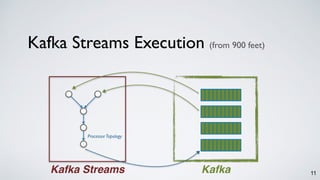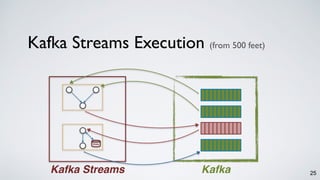Performance Analysis and Optimizations for Kafka Streams Applications
- 1. Performance Analysis and Optimizations for Kafka Streams Guozhang Wang Kafka Summit London, May. 14, 2019
- 2. Outline • Streams application execution: from 1000 to 400 feet • Processor topology generation: an optimization problem • Kafka Streams topology optimization framework 2
- 3. 3 So you want to write a Streams app?
- 4. 4 Step I: Read the demo streams/examples/src/main/java/o.a.k.streams/examples/wordcount/WordCountDemo.java
- 5. 5 Step II: Modify the demo code to yours
- 6. kubectl create -f my-kafka-streams-deployment.yaml Deployment “my-kafka-streams-app” created kubectl scale deployment my-kafka-streams-app --replicas=2 Deployment “my-kafka-streams-app” scaled 6 java -cp /my/app -Dlog4j.configuration=file:/my/app/conf/log4j.properties / -Dcom.sun.management.jmxremote.authenticate=false / -Dcom.sun.management.jmxremote.ssl=false / -Dcom.sun.management.jmxremote.port=17072 / -XX:+UseGCLogFileRotation -XX:GCLogFileSize=10M / -Xloggc:/my/app/logs/GC.log / my.streams.MyStreamsApp /my/app/conf/config.properties The fancy way The not-so-fancy way Step III: Run It! [Kafka Summit SF 2018, Shapira & Sax]
- 10. 10 Kafka Streams Execution Kafka Streams Kafka StreamThread JVM (from 1000 feet)
- 11. 11 Kafka Streams Execution Kafka Streams Kafka ProcessorTopology (from 900 feet)
- 12. Define your Processor Topology in DSL 12 KStream<..> stream1 = builder.stream(”topic1”); KStream<..> stream2 = builder.stream(”topic2”); KStream<..> joined = stream1.leftJoin(stream2, ...); KTable<..> aggregated = joined.groupBy(…).aggregate(…); aggregated.toStream().to(”topic3”);
- 13. Define your Processor Topology in DSL 13 KStream<..> stream1 = builder.stream(”topic1”); KStream<..> stream2 = builder.table(”topic2”); .addSource(”Source2”, ”topic2”) topology.addSource(”Source1”, ”topic1”) .addProcessor(”Join”, LeftJoin:new, ”Source1”, ”Source2”) .addProcessor(”Aggregate”, Aggregate:new, ”Join”) .addStateStore(Stores.persistent(…).build(), ”Aggregate”) .addSink(”Sink”, ”topic3”, ”Aggregate”) State
- 14. Examine your Processor Topology 14 State topology.addSource(”Source1”, ”topic1”) .addProcessor(”Join”, LeftJoin:new, ”Source1”, ”Source2”) .addProcessor(”Aggregate”, Aggregate:new, ”Join”) .addStateStore(Stores.persistent(…).build(), ”Aggregate”) .addSink(”Sink”, ”topic3”, ”Aggregate”) .addSource(”Source2”, ”topic2”) topology = builder.build(); System.out.println(topology.describe());
- 15. 15 Topologies: Sub-topology: 0 Source: KSTREAM-SOURCE-0000000000 (topics: [topic1]) --> KSTREAM-WINDOWED-0000000002 Source: KSTREAM-SOURCE-0000000001 (topics: [topic2]) --> KSTREAM-WINDOWED-0000000003 …… Processor: KSTREAM-KEY-SELECT-0000000007 (stores: []) --> KSTREAM-FILTER-0000000011 <-- KSTREAM-MERGE-0000000006 …… Sink: KSTREAM-SINK-0000000010 (topic: MyAggStore-repartition) <-- KSTREAM-FILTER-0000000011 Sub-topology: 1 Source: KSTREAM-SOURCE-0000000012 (topics: [MyAggStore-repartition]) --> KSTREAM-AGGREGATE-0000000009 Processor: KSTREAM-AGGREGATE-0000000009 (stores: [MyAggStore]) --> KTABLE-TOSTREAM-0000000013 <-- KSTREAM-SOURCE-0000000012 …… Sink: KSTREAM-SINK-0000000014 (topic: topic3) <-- KTABLE-TOSTREAM-0000000013 That looks familiar.. State [Kafka Streams Topology Visualizer. https://zz85.github.io/kafka-streams-viz/]
- 16. 16 Topologies: Sub-topology: 0 Source: KSTREAM-SOURCE-0000000000 (topics: [topic1]) --> KSTREAM-WINDOWED-0000000002 Source: KSTREAM-SOURCE-0000000001 (topics: [topic2]) --> KSTREAM-WINDOWED-0000000003 …… Processor: KSTREAM-KEY-SELECT-0000000007 (stores: []) --> KSTREAM-FILTER-0000000011 <-- KSTREAM-MERGE-0000000006 …… Sink: KSTREAM-SINK-0000000010 (topic: MyAggStore-repartition) <-- KSTREAM-FILTER-0000000011 Sub-topology: 1 Source: KSTREAM-SOURCE-0000000012 (topics: [MyAggStore-repartition]) --> KSTREAM-AGGREGATE-0000000009 Processor: KSTREAM-AGGREGATE-0000000009 (stores: [MyAggStore]) --> KTABLE-TOSTREAM-0000000013 <-- KSTREAM-SOURCE-0000000012 …… Sink: KSTREAM-SINK-0000000014 (topic: topic3) <-- KTABLE-TOSTREAM-0000000013 Hmm, that looks bizarre? State [Kafka Streams Topology Visualizer. https://zz85.github.io/kafka-streams-viz/]
- 17. 17 Data Parallelism 101 (specially tailored for Kafka) Topic 1 Partitions Producers Consumers
- 18. 18 Data Parallelism 101 (specially tailored for Kafka) groupBy(…).count(…)
- 19. 19 Data Parallelism 101 (specially tailored for Kafka) groupBy(…).count(…)
- 20. 20 Data Parallelism 101 (specially tailored for Kafka) groupBy(…).count(…)
- 21. 21 Data Parallelism 101 (specially tailored for Kafka) groupBy(…).count(…) count 3 3 3 3
- 22. 22 Shuffling in Streams: RepartitionTopics State
- 23. 23 Shuffling in Streams: RepartitionTopics State
- 24. 24 Shuffling in Streams: RepartitionTopics State Repartition Topic (partition key = grouped key) Topologies: Sub-topology: 0 …… Sink: KSTREAM-SINK-0000000010 (topic: MyAggStore-repartition) <-- KSTREAM-FILTER-0000000011 Sub-topology: 1 Source: KSTREAM-SOURCE-0000000012 (topics: [MyAggStore-repartition]) --> KSTREAM-AGGREGATE-0000000009 ……
- 25. 25Kafka Streams Kafka Kafka Streams Execution (from 500 feet) State
- 26. Kafka Topic B Task2Task1 Stream Partitions and Tasks 26 Kafka Topic A
- 27. Kafka Topic B Stream Partitions and Tasks 27 Kafka Topic A Task2Task1
- 28. 28Kafka Streams Kafka Kafka Streams Execution (from 400 feet) State State instance-1 instance-2 instance-3
- 29. 29 Repartition Topics for Shuffling State State instance-1 instance-2 instance-3 … …
- 30. 30 Case #1: Duplicate Repartitioning KStream source = builder.stream(“topic1"); KStream mapped = source.map(..); KTable counts = mapped.groupByKey().aggregate(..); KStream sink = mapped.leftJoin(counts, ..);
- 31. 31 Case #1: Duplicate Repartitioning KStream source = builder.stream(“topic1"); KStream mapped = source.map(..); KTable counts = mapped.groupByKey().aggregate(..); KStream sink = mapped.leftJoin(counts, ..);
- 32. 32 Case #1: Duplicate Repartitioning KStream source = builder.stream(“topic1"); KStream mapped = source.map(..); KTable counts = mapped.groupByKey().aggregate(..); KStream sink = mapped.leftJoin(counts, ..); Map State Agg agg-repartition
- 33. 33 Case #1: Duplicate Repartitioning KStream source = builder.stream(“topic1"); KStream mapped = source.map(..); KTable counts = mapped.groupByKey().aggregate(..); KStream sink = mapped.leftJoin(counts, ..); Map State Join Agg map-join-repartition agg-repartition
- 34. 34 Case #1: Duplicate Repartitioning KStream source = builder.stream(“topic1"); KStream mapped = source.map(..); KTable counts = mapped.groupByKey().aggregate(..); KStream sink = mapped.leftJoin(counts, ..); Map State Join Agg map-join-repartition agg-repartition
- 35. 35 Case #1: Duplicate Repartitioning KStream source = builder.stream(“topic1"); KStream shuffled = source.map(..) .through(“topic2”); KTable counts = shuffled.groupByKey().count(..); KStream sink = shuffled.leftJoin(counts, ..);
- 36. 36 Case #1: Duplicate Repartitioning KStream source = builder.stream(“topic1"); KStream shuffled = source.map(..) .through(“topic2”); KTable counts = shuffled.groupByKey().count(..); KStream sink = shuffled.leftJoin(counts, ..); Map topic2
- 37. 37 Case #1: Duplicate Repartitioning KStream source = builder.stream(“topic1"); KStream shuffled = source.map(..) .through(“topic2”); KTable counts = shuffled.groupByKey().count(..); KStream sink = shuffled.leftJoin(counts, ..); Map State Agg topic2
- 38. 38 Case #1: Duplicate Repartitioning KStream source = builder.stream(“topic1"); KStream shuffled = source.map(..) .through(“topic2”); KTable counts = shuffled.groupByKey().count(..); KStream sink = shuffled.leftJoin(counts, ..); Map State Join Agg topic2
- 39. 39 Key-Changing Operations Key-Value Value Only map mapValues flatMap flatMapValues transform transformValues flatTransform flatTransformValues
- 40. 40 Case #2: Clumsy Repartitioning KStream source = builder.stream(“topic1"); KTable aggregated = source.groupBy(..).count(..);
- 41. 41 Case #2: Clumsy Repartitioning SelectKey Agg agg-repartition KStream source = builder.stream(“topic1"); KTable aggregated = source.groupBy(..).count(..); State
- 42. 42 Case #2: Clumsy Repartitioning SelectKey Agg agg-repartition KStream source = builder.stream(“topic1"); KTable aggregated = source.groupBy(..).count(..); State
- 43. 43 Case #2: Clumsy Repartitioning KStream source = builder.stream(“topic1"); KStream projected = source.mapValues(..); KTable aggregated = projected.groupBy(..).count(..);
- 44. 44 Case #2: Clumsy Repartitioning KStream source = builder.stream(“topic1"); KStream projected = source.mapValues(..); KTable aggregated = projected.groupBy(..).count(..); mapValues
- 45. 45 Case #2: Clumsy Repartitioning KStream source = builder.stream(“topic1"); KStream projected = source.mapValues(..); KTable aggregated = projected.groupBy(..).count(..); SelectKey mapValues Agg agg-repartition State
- 46. 46 Topology Generation(an optimization problem) Define: write DSL code Examine: topology.describe Refine: modify DSL code Examine: topology.describe …
- 47. 47 Topology Generation(an optimization problem) Define: write DSL code Examine: topology.describe Refine: modify DSL code Examine: topology.describe … Root Cause: Step-by-step Translation
- 48. 48 Do I Really have to learn all this? No! (beyond Kafka 2.1)
- 49. 49 Key Idea: Replace step-by-step translation with logical plan compilation
- 50. 50 Topology Optimization Framework User DSL code Processor Topology Parsing and Generation
- 51. 51 Topology Optimization Framework User DSL code Logical Plan: Operator Graph Physical Plan: Processor Topology Parsing Compilation Logical plan optimization
- 52. 52 Logical Plan Optimization • Currently rule based • Repartitioning push-up and consolidation • Sharing topics for source / changelog • Logical views for table materialization [2.2+] • etc..
- 53. 53 Case #3: Unnecessary Materialization KTable table1 = builder.table(“topic1"); KTable table2 = builder.table(“topic2"); table1.filter().join(table2, ..); StateState
- 54. 54 Case #3: Unnecessary Materialization KTable table1 = builder.table(“topic1"); KTable table2 = builder.table(“topic2"); table1.filter().join(table2, ..); filter StateState
- 55. 55 Case #3: Unnecessary Materialization KTable table1 = builder.table(“topic1"); KTable table2 = builder.table(“topic2"); table1.filter().join(table2, ..); filter StateState join
- 56. 56 Case #3: Unnecessary Materialization KTable table1 = builder.table(“topic1"); KTable table2 = builder.table(“topic2"); table1.filter().join(table2, ..); filter State State State join
- 57. 57 Case #3: Unnecessary Materialization KTable table1 = builder.table(“topic1"); KTable table2 = builder.table(“topic2"); table1.filter().join(table2, ..); filter State State State join
- 58. 58 Case #3 with Optimization Enabled KTable table1 = builder.table(“topic1"); KTable table2 = builder.table(“topic2"); table1.filter().join(table2, ..); filter State View State join
- 59. 59 Case #3 with Optimization Enabled KTable table1 = builder.table(“topic1"); KTable table2 = builder.table(“topic2"); table1.filter().join(table2, ..); filter State View State join
- 60. 60 Enable Topology Optimization config: topology.optimization = all (default = none) [KIP-295] code: StreamBuilder#build(props) upgrade: watch out for compatibility [https://www.confluent.io/blog/data-reprocessing-with-kafka-streams-resetting-a-streams-application/]
- 61. 61 What’s next [KIP-372, KIP-307] • Extensible optimization framework • More re-write rules! • Beyond all-or-nothing config • Compatibility support for optimized topology [KAFKA-6034]
- 62. Take-aways • Optimize your topology for better performance and less footprint 62 System.out.println(topology.describe());
- 63. Take-aways • Optimize your topology for better performance and less footprint • It’s OK if you forget the first bullet point: Kafka Streams will help doing that for you! 63 System.out.println(topology.describe());
- 64. Take-aways 64 THANKS! Guozhang Wang | [email protected] | @guozhangwang • Optimize your topology for better performance and less footprint • It’s OK if you forget the first bullet point: Kafka Streams will help doing that for you! System.out.println(topology.describe());






![kubectl create -f my-kafka-streams-deployment.yaml
Deployment “my-kafka-streams-app” created
kubectl scale deployment my-kafka-streams-app --replicas=2
Deployment “my-kafka-streams-app” scaled
6
java -cp /my/app -Dlog4j.configuration=file:/my/app/conf/log4j.properties /
-Dcom.sun.management.jmxremote.authenticate=false /
-Dcom.sun.management.jmxremote.ssl=false /
-Dcom.sun.management.jmxremote.port=17072 /
-XX:+UseGCLogFileRotation -XX:GCLogFileSize=10M /
-Xloggc:/my/app/logs/GC.log /
my.streams.MyStreamsApp /my/app/conf/config.properties
The fancy way
The not-so-fancy
way
Step III: Run It!
[Kafka Summit SF 2018, Shapira & Sax]](https://image.slidesharecdn.com/kafkastreamsoptimizationkafkasummitlondon2019slides-190514151702/85/Performance-Analysis-and-Optimizations-for-Kafka-Streams-Applications-6-320.jpg)








![15
Topologies:
Sub-topology: 0
Source: KSTREAM-SOURCE-0000000000 (topics: [topic1])
--> KSTREAM-WINDOWED-0000000002
Source: KSTREAM-SOURCE-0000000001 (topics: [topic2])
--> KSTREAM-WINDOWED-0000000003
……
Processor: KSTREAM-KEY-SELECT-0000000007 (stores: [])
--> KSTREAM-FILTER-0000000011
<-- KSTREAM-MERGE-0000000006
……
Sink: KSTREAM-SINK-0000000010 (topic: MyAggStore-repartition)
<-- KSTREAM-FILTER-0000000011
Sub-topology: 1
Source: KSTREAM-SOURCE-0000000012 (topics: [MyAggStore-repartition])
--> KSTREAM-AGGREGATE-0000000009
Processor: KSTREAM-AGGREGATE-0000000009 (stores: [MyAggStore])
--> KTABLE-TOSTREAM-0000000013
<-- KSTREAM-SOURCE-0000000012
……
Sink: KSTREAM-SINK-0000000014 (topic: topic3)
<-- KTABLE-TOSTREAM-0000000013
That looks familiar..
State
[Kafka Streams Topology Visualizer. https://zz85.github.io/kafka-streams-viz/]](https://image.slidesharecdn.com/kafkastreamsoptimizationkafkasummitlondon2019slides-190514151702/85/Performance-Analysis-and-Optimizations-for-Kafka-Streams-Applications-15-320.jpg)
![16
Topologies:
Sub-topology: 0
Source: KSTREAM-SOURCE-0000000000 (topics: [topic1])
--> KSTREAM-WINDOWED-0000000002
Source: KSTREAM-SOURCE-0000000001 (topics: [topic2])
--> KSTREAM-WINDOWED-0000000003
……
Processor: KSTREAM-KEY-SELECT-0000000007 (stores: [])
--> KSTREAM-FILTER-0000000011
<-- KSTREAM-MERGE-0000000006
……
Sink: KSTREAM-SINK-0000000010 (topic: MyAggStore-repartition)
<-- KSTREAM-FILTER-0000000011
Sub-topology: 1
Source: KSTREAM-SOURCE-0000000012 (topics: [MyAggStore-repartition])
--> KSTREAM-AGGREGATE-0000000009
Processor: KSTREAM-AGGREGATE-0000000009 (stores: [MyAggStore])
--> KTABLE-TOSTREAM-0000000013
<-- KSTREAM-SOURCE-0000000012
……
Sink: KSTREAM-SINK-0000000014 (topic: topic3)
<-- KTABLE-TOSTREAM-0000000013
Hmm, that looks bizarre?
State
[Kafka Streams Topology Visualizer. https://zz85.github.io/kafka-streams-viz/]](https://image.slidesharecdn.com/kafkastreamsoptimizationkafkasummitlondon2019slides-190514151702/85/Performance-Analysis-and-Optimizations-for-Kafka-Streams-Applications-16-320.jpg)







![24
Shuffling in Streams: RepartitionTopics
State
Repartition Topic (partition key = grouped key)
Topologies:
Sub-topology: 0
……
Sink: KSTREAM-SINK-0000000010 (topic: MyAggStore-repartition)
<-- KSTREAM-FILTER-0000000011
Sub-topology: 1
Source: KSTREAM-SOURCE-0000000012 (topics: [MyAggStore-repartition])
--> KSTREAM-AGGREGATE-0000000009
……](https://image.slidesharecdn.com/kafkastreamsoptimizationkafkasummitlondon2019slides-190514151702/85/Performance-Analysis-and-Optimizations-for-Kafka-Streams-Applications-24-320.jpg)



























![52
Logical Plan Optimization
• Currently rule based
• Repartitioning push-up and consolidation
• Sharing topics for source / changelog
• Logical views for table materialization [2.2+]
• etc..](https://image.slidesharecdn.com/kafkastreamsoptimizationkafkasummitlondon2019slides-190514151702/85/Performance-Analysis-and-Optimizations-for-Kafka-Streams-Applications-52-320.jpg)







![60
Enable Topology Optimization
config: topology.optimization = all
(default = none)
[KIP-295]
code: StreamBuilder#build(props)
upgrade: watch out for compatibility
[https://www.confluent.io/blog/data-reprocessing-with-kafka-streams-resetting-a-streams-application/]](https://image.slidesharecdn.com/kafkastreamsoptimizationkafkasummitlondon2019slides-190514151702/85/Performance-Analysis-and-Optimizations-for-Kafka-Streams-Applications-60-320.jpg)
![61
What’s next
[KIP-372, KIP-307]
• Extensible optimization framework
• More re-write rules!
• Beyond all-or-nothing config
• Compatibility support for optimized topology
[KAFKA-6034]](https://image.slidesharecdn.com/kafkastreamsoptimizationkafkasummitlondon2019slides-190514151702/85/Performance-Analysis-and-Optimizations-for-Kafka-Streams-Applications-61-320.jpg)




















































![[HIFLUX] High Pressure Tube Support Catalog 2025](https://cdn.slidesharecdn.com/ss_thumbnails/tubesupporten-250529073613-16c22974-thumbnail.jpg?width=560&fit=bounds)









